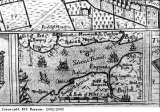Bristol’s slave ships
Bristol slaving ships ranged from tiny ships of 27 tons (roughly the size of an articulated lorry) to giants of 420 tons (about 16 times larger). The wooden sailing ships used for the slave trade usually had two or three masts with many sails and complex rigging. They required skilful deck hands to look after them, especially in the changeable weather conditions that could be expected in the Atlantic Ocean. Slaving ships had large hulls, which would have been used for carrying the goods to be traded, as well as equipment and food for the journey. The hull was also expected to hold up to 600 enslaved Africans on the journey from Africa to the Caribbean islands.
The round trip, from Bristol to Africa and the Americas and back to Bristol, normally took about 12 months. Conditions on the ships were hard and dangerous, and sailors were often reluctant to sail on them. They were often forced on board the ship when drunk or through debt. Captains of slave ships had a reputation for cruelty, and both crew and African slaves suffered. (For more about this see The People Involved: Sailors narrative).
From Bristol, down the River Avon and out to the sea was a difficult journey. This picture A View of the Hotwell, shows three large ships being towed out of the city’s docks by rowing boats. In Bristol’s muddy dock, the largest ships could only leave on the highest tides when there was enough water for the ships to float. This was because at low tide the ships settled into the mud of the river bed. The high tides lasted for just a few hours. Outgoing ships could wait for the high tides at the quayside, and incoming ships could wait several miles up river, for up to a month. Once out of the dock, ships could not easily sail up or down the River Avon, and a pilot (someone who knows the river and its tides) came on board the ship to navigate along the river. The fast water and the winding route made it necessary for ships to be towed out, by up to ten smaller boats, rather than sailing. The three larger ships are being towed out by rowing boats. The Bristol slave ship the Black Prince was towed in 1762 down the river by 3 towboats, 2 yawls (small rowing boats), 6 oxen and 2 horses. This section of a map from 1673 shows the area where the Rivers Avon and Severn met. This is where the ships would have waited for crew to board or until the tide was high enough for the ships to sail.
Once the sea was reached, the time taken in sailing to Africa was dependant on the weather and on the skills of the crew. The ship the Scipio in 1734 reached the coast of Gambia, West Africa, in 25 days. The Amelia in 1759 took 54 days to reach the nearby Cape Coast.
Some 2,108 slaving voyages set out from Bristol between 1698 and 1807. The number of voyages varied, from over 50 each year in the 1730s, to less than 8 a year in the 1800s. As the number of slaving voyages decreased due to competition from Liverpool and London, the other cities involved in the slave trade, more Bristol ships became involved instead in trading directly with the Caribbean and America. Eventually in the 1800s Bristol’s trade in slaves stopped altogether when the slave trade was made illegal. However, some British merchants continued to invest in the slave trade through Spanish, Portuguese and American traders. The slave trade was still legal in those countries, and British merchants supplied trade goods and banking capital to foreign slave traders.



